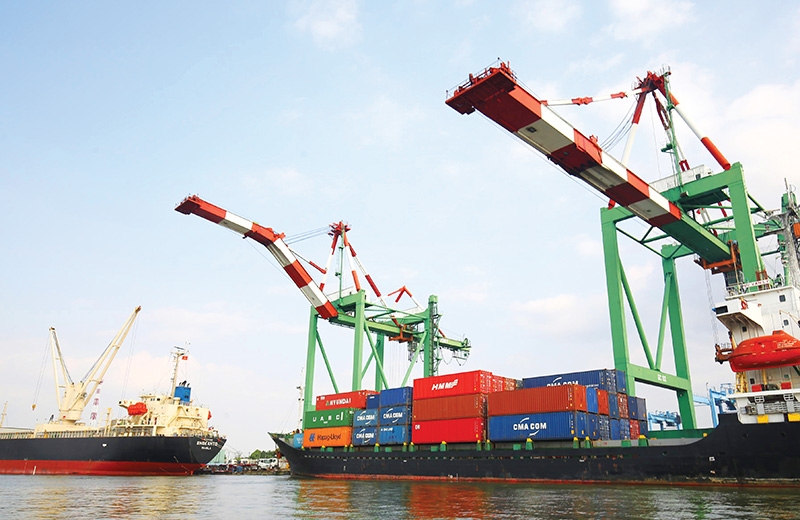Aligning with trade remedy principles
 |
| New legal measures will support local manufacturing in the face of stronger import competition. Photo: Le Toan |
To date, Vietnam boasts 14 effective FTAs which focus on lessening tariffs, helping many kinds of services flourish, and aiding investment in science and technology. These agreements are an essential motivation for Vietnamese economic development. As the nation has enhanced participation in such FTAs, trade remedies like anti-dumping, countervailing, and safeguarding regimes become more meaningful for companies as well as the economy. These legal measures are expected to effectively support the local manufacturing sector as the competition with imports is growing fiercer.
As of now, the European Union has inspected 14 trade remedy cases, including six regarding local exports’ anti-tax avoidance, and occupying 8 per cent of the total number of such cases related to Vietnam as a whole. The scrutinised products consist of such items as leather shoes and caps, bicycles, steel, cigarette lighters, fluorescent lamps, zinc oxide, and sodium glutamate.
The trade remedy regulations stem from World Trade Organization policies, and are adjusted to be in line with Vietnamese trade remedy principles. They aim to legally protect the local economy and all sectors, assuring the efficiency of joining the agreements.
The principles include, firstly, providing the regulations related to restricting utilisation of tools to avoid manhandling, and assuring equality and transparency. Those will create a stable and more favourable business climate for export companies.
Secondly, the EVFTA regulates applying the lower tax rate – in other words, the anti-dumping tax rate or countervailing tax rate only stops at a level that is enough to eliminate damages.
Moreover, the agreement also stipulates that the two sides will not apply the anti-dumping and countervailing measures if they do not comply with the public interest. In addition to reviewing the performance of the local manufacturing sector, it is necessary to scrutinise the view of exporters, industry associations, and organisations on behalf of consumers and downstream companies.
Thirdly, the EVFTA also stipulates the bilateral protection regime to make sure the tariff cuts do not cause any shocks on local industries with the 10-year timeline. In addition, the agreement creates a legal basis to assure the interests of both sides using self-protection tools on local manufacturing activities in case they are facing difficulties or are threatened by agreement tariff cuts.
The Ministry of Industry and Trade (MoIT) has been making preparations for meeting trade remedy requirements over the years. Firstly, relating to strengthening investigation authorities, in 2017 the MoIT founded the Trade Remedies Authority of Vietnam. Secondly, the following year Vietnam launched the Law on Foreign Trade Management and guideline documents on trade remedy, as per Decree No.10/2018/ND-CP outlining law guidelines and 2011’s Circular No.37/2019/TT-BCT providing detailed trade remedy regulations. Thus, the nation has largely completed the legal framework for related investigations. In addition, the ministry is planning to issue a circular which will outline further guidelines of applying the trade remedies under the EVFTA.
Lastly the MoIT has been planning to disseminate information on trade remedies, in particular those in accordance with the EVFTA.
What the stars mean:
★ Poor ★ ★ Promising ★★★ Good ★★★★ Very good ★★★★★ Exceptional
Themes: EVFTA & EVIPA
Related Contents
Latest News
More News
- Long-term capital seen as key hurdle to green growth (December 16, 2025 | 08:00)
- HDS Summit spotlights Vietnam’s rising role in regional supply chains (December 16, 2025 | 08:00)
- Agribank frames bank credit as catalyst for green growth (December 15, 2025 | 17:59)
- Legal framework completed for national digital transformation (December 13, 2025 | 21:55)
- SOAR initiative launched at TECHFEST Vietnam 2025 (December 13, 2025 | 10:00)
- Promoting digital assets initiative in Vietnam (December 13, 2025 | 09:30)
- Legislation gives government flexibility for loan guarantees (December 11, 2025 | 18:04)
- Vietnam masters core technologies of automobile value chain (December 11, 2025 | 17:46)
- Japanese investors pursue M&A strategies with long-term vision in Vietnam (December 11, 2025 | 12:14)
- Raising product quality to secure Vietnam’s position in US market (December 11, 2025 | 12:00)

 Tag:
Tag:






















 Mobile Version
Mobile Version